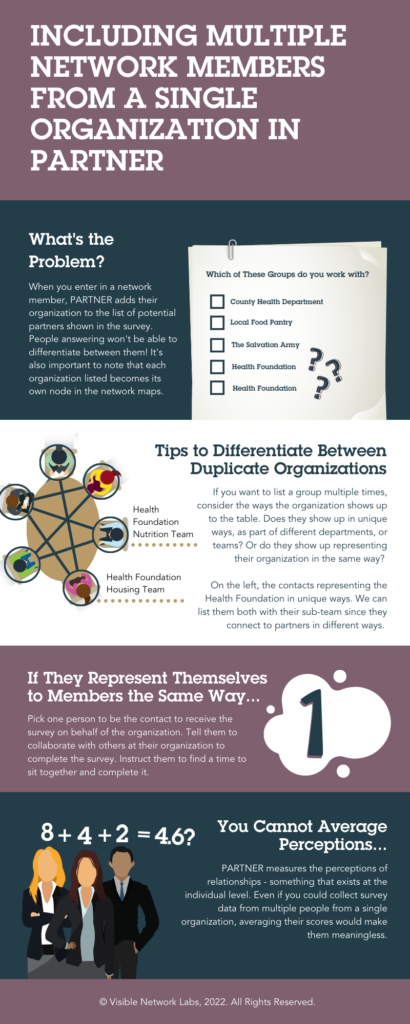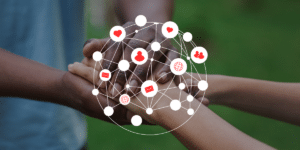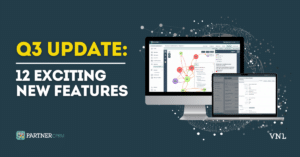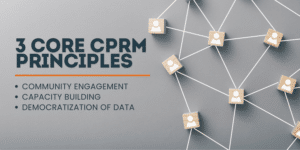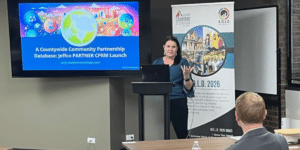Including Multiple Network Members from a Single Organization in PARTNER
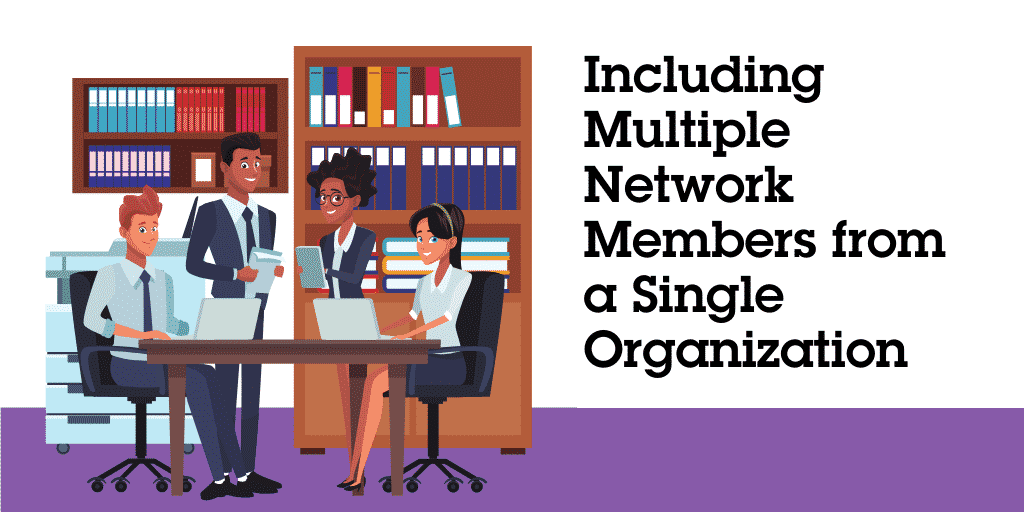
One of the most common questions we get early on in projects involves including multiple members from a single organization in PARTNER. Groups that work with 2 or more individuals at a partner nonprofit, for example, want to get both of their perspectives. However this causes a few problems from a network science perspective. Here’s an infographic and explanation of what’s going on and how you can implement some work-around solutions.
What’s the Problem?
When you enter a respondent (organization/individual) into PARTNER the organization is automatically added to the list shown for the network member selection question. If you were to include two organizations with the exact same name, both would show up on the list and confuse respondents. People answering wouldn’t be able to differentiate between them. PARTNER prevents duplicate organization names so respondents can have a clear understanding of which partners are on the list for them to choose. It is important to note that each organization listed becomes its own node in the network maps.
Tips for Avoiding Duplicates.
If you want to list an organization multiple times in the member list, consider the ways the organization shows up to the table. Does the organization show up in unique ways? Perhaps as part of different departments, sub-units, or teams. Or do they show up representing the organization in the same way? (See next section)
We suggest you differentiate duplicate organizations by including the department, team, program, or sub-unit in the organization name. The example to the left shows two contacts representing the Health Foundation in unique ways. Therefore, should show up as separate nodes in maps because partners connect to them differently. If the contacts are representing the Health Foundation in the same way at the table (say as Program Officers), then it should only be one node in the maps because partners connect to those contacts from the Health Foundation in the same way.
If They Represent Themselves the Same Way…
Pick one representative to be the contact to receive the survey on behalf of the organization. Give instructions for them to collaborate with any others at their organization to complete the survey. Instruct them not to forward their survey link to the next person to complete, but rather find a time to sit together to complete. The risk is that the next person could completely change the first’s answers vs collaborating on the answers together.
You Cannot Average Perceptions of Relationships.
PARTNER measures the perceptions of relationships and being able to visualize and analyze the unique ways organizations show up to community networks is powerful. Data could show that network members may connect to the org through various activities, have relationships that lead to several outcomes, or value or trust one area of an organization differently than another. For instance, say the Local Food Pantry chose the Health Foundation Nutrition Team and the Health Foundation Community Housing Team as partners. The Food Pantry has a highly valued, trusted, integrated relationship with the Nutrition Team, but is only developing their relationship with the Community Housing Team (lower value and trust scores and only cooperative level activities). If you were you to average those relationships to show the Food Pantry’s relationship with the Health Foundation as a whole, it would not accurately show that relationship well. Averaging relationships does not provide true context into the various perceptions network members have with different parts of the same organizations.

About the Author: Alex Derr, M.P.A.
Director of Marketing & Communications
Alex joined VNL in 2017, originally supporting our events. He now helps manages our communications and marketing strategy and content development work. Alex creates blogs, infographics, reports, and other content while managing our web and social media presence. He also runs our email marketing campaigns, tracks analytics, and conducts market research to drive our strategy. He supports our entire team with copywriting, graphic design and research, and helps with events, webinars, demos, and other online learning. When he isn’t at work Alex spends his time climbing 14ers (30 done, 28 to go!) and blogging on his own website, The Next Summit Blog.
